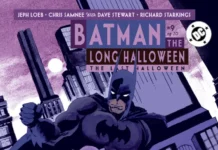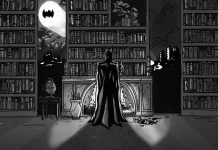By Trey Jackson
 Like I said in my review for issue #1, I wasn’t sure what to expect from this project. Letting an actor turn his character’s backstory into their own comic is a bit of a risk. But DC knows what they’re doing. Issue 1 was a treat and a pleasant surprise, and I’m happy to say that level of quality continues in issue #2 and will hopefully continue throughout the rest of the book. I think it will.
Like I said in my review for issue #1, I wasn’t sure what to expect from this project. Letting an actor turn his character’s backstory into their own comic is a bit of a risk. But DC knows what they’re doing. Issue 1 was a treat and a pleasant surprise, and I’m happy to say that level of quality continues in issue #2 and will hopefully continue throughout the rest of the book. I think it will.
We left off at the end of issue #1 with Edward learning that his firm (and bosses) might be connected to some significant criminal activity. Issue 2 picks up here and shows us that Edward’s supervisor Zach has been promoted, probably not unrelated to his involvement revealed at the end of issue #1. Edward wants to forget about what he thinks he’s discovered, but he can’t. He can’t leave a riddle unsolved, and he can’t accept the thought that he might be an insignificant nobody who made a mistake at work with his suspicions. So he sneaks into Mr. Stone’s office (the higher-up who Edward hoped to impress) looking for confirmation. He finds a connection to another company, Waterfront Industries, and a missing page from the business ledger shredded into the trash can. This leads him to another potential criminal connection, Mr. Joon, that bears investigation. But the big reveal here is the same big reveal in the movie:
The Wayne Renewal fund is a front for money laundering.
Just as we saw in the movie, this has major potential political ramifications. But we also see here that there are some very personal ramifications for Edward too. He decides to track down Mr. Joon to find out more, just as Mr. Stone tries to divert his attention with a project reviewing the accounts at Wayne Enterprises. This convinces him that he can’t go to anyone at his company with his findings, and his online “friends” at Nigma convince him that the police won’t be any help either. It’s another step in his journey toward taking things into his own hands. We even see the beginnings of his Riddler disguise purchased at a military surplus store. And we get a great sequence of alternating Riddler and Batman action beats, driving home the fact that in Edward’s mind, these two are very much on the same mission. Some elementary hacking allows him to spy on Mr. Joon and find out what he’s been up to, including a meeting with Mr. Stone. This leads to another big reveal that piques Edward’s interest and one that movie audiences will recognize: the involvement of Mr. Falcone. But tragically, it also lets Edward see that Mr. Joon is in trouble because Edward initially went to Mr. Stone with his questions. I won’t spoil what happens next, but the Black Label artistic license is on display.
Some overall impressions:
The Story: I’m very interested to see where this goes. We’re starting to see more and more of the movie’s plot points introduced, and as a result, the conspiracies are getting wider while the story gets deeper. But the highlight is seeing Edward come into focus as the Riddler. Speaking of which…
Characters: This is very much Edward’s story, and his interactions with other characters are minimal. Dialogue is written as white speech bubbles, his inner monologue is grey squares, count the times each is used and compare if you want to see just how in his own head Edward really is (including one conversation that could be either, I’m curious to see which). But the other characters are important parts of his development. The book begins with a flashback to a conversation from Edward’s childhood between himself and Thomas Wayne, a potential father figure telling an orphan that he matters and has a future. The same father figure, as you know, would go on to be murdered under mysterious circumstances, tied to conspiracies, and his renewal fund would become a money laundering scheme that literally rejected Edward’s pleas for help in the form of denied hardship applications. Are you seeing the path of Edward’s downfall yet? I’ve written elsewhere that one of the main themes in The Batman is the importance of fathers, both good and bad. This book is clearly picking up on the tragic side of that story thread. In addition to that, we see tangible beginnings of Edward’s mission to cleanse Gotham here and his perceived alliance with Batman. At one point he’s about to have one of his mini-breakdowns and he’s only able to stop it by focusing on his investigation, the riddle he’s trying to solve. When he’s not trying to solve this riddle, he’s sincerely asking himself why it has to be so painful to be alive, so we shouldn’t be surprised at where he’s headed.
Art: a nitpick I had with the art in issue #1 was the way characters other than Edward were portrayed. Maybe it’s because they’re not as prominent in issue 2, or maybe it didn’t bother me because they don’t matter as much and their distortions might just be how Edward sees them. But in any case, I have no nitpicks about the artwork here, in fact, I think artist Stevan Subic is doing some wonderful work in this book. The visualizations of Edward’s mental state – a standout in issue 1 – are excellent here too. His memories and daydreams morph between ordinary images and Lovecraftian horror creatures. The different color schemes in each panel, especially the glowing blues of screens, do a great job of creating the sense of depressed detachment Edward inhabits. Also, Edward is apparently a fan of some classic Batman books, judging by his monitors on the cover.
Nitpicks: None. This is a great book, and I’m excited to see where it goes. – Trey Jackson
GRADE: A+












